Shisong Li
Metering Error Estimation of Fast-Charging Stations Using Charging Data Analytics
Mar 03, 2025



Abstract:Accurate electric energy metering (EEM) of fast charging stations (FCSs), serving as critical infrastructure in the electric vehicle (EV) industry and as significant carriers of vehicle-to-grid (V2G) technology, is the cornerstone for ensuring fair electric energy transactions. Traditional on-site verification methods, constrained by their high costs and low efficiency, struggle to keep pace with the rapid global expansion of FCSs. In response, this paper adopts a data-driven approach and proposes the measuring performance comparison (MPC) method. By utilizing the estimation value of state-of-charge (SOC) as a medium, MPC establishes comparison chains of EEM performance of multiple FCSs. Therefore, the estimation of EEM errors for FCSs with high efficiency is enabled. Moreover, this paper summarizes the interfering factors of estimation results and establishes corresponding error models and uncertainty models. Also, a method for discriminating whether there are EEM performance defects in FCSs is proposed. Finally, the feasibility of MPC method is validated, with results indicating that for FCSs with an accuracy grade of 2\%, the discriminative accuracy exceeds 95\%. The MPC provides a viable approach for the online monitoring of EEM performance for FCSs, laying a foundation for a fair and just electricity trading market.
A Self-Healing Magnetic-Array-Type Current Sensor with Data-Driven Identification of Abnormal Magnetic Measurement Units
Feb 18, 2024



Abstract:Magnetic-array-type current sensors have garnered increasing popularity owing to their notable advantages, including broadband functionality, a large dynamic range, cost-effectiveness, and compact dimensions. However, the susceptibility of the measurement error of one or more magnetic measurement units (MMUs) within the current sensor to drift significantly from the nominal value due to environmental factors poses a potential threat to the measurement accuracy of the current sensor.In light of the need to ensure sustained measurement accuracy over the long term, this paper proposes an innovative self-healing approach rooted in cyber-physics correlation. This approach aims to identify MMUs exhibiting abnormal measurement errors, allowing for the exclusive utilization of the remaining unaffected MMUs in the current measurement process. To achieve this, principal component analysis (PCA) is employed to discern the primary component, arising from fluctuations of the measured current, from the residual component, attributed to the drift in measurement error. This analysis is conducted by scrutinizing the measured data obtained from the MMUs. Subsequently, the squared prediction error (SPE) statistic (also called $Q$ statistic) is deployed to individually identify any MMU displaying abnormal behavior. The experimental results demonstrate the successful online identification of abnormal MMUs without the need for a standard magnetic field sensor. By eliminating the contributions from the identified abnormal MMUs, the accuracy of the current measurement is effectively preserved.
A SVD-based Dynamic Harmonic Phasor Estimator with Improved Suppression of Out-of-Band Interference
Nov 16, 2022



Abstract:The diffusion of nonlinear loads and power electronic devices in power systems deteriorates the signal environment and increases the difficulty of measuring harmonic phasors. Considering accurate harmonic phasor information is necessary to deal with harmonic-related issues, this paper focuses on realizing accurate dynamic harmonic phasor estimation when the signal is contaminated by certain interharmonic tones, i.e. the out-of-band interference (OBI). Specifically, this work introduces the singular value decomposition into the Taylor-Fourier transform algorithm, deriving a general decomposition form for harmonic phasor filters, and yielding a set of adjustable parameters. Then these parameters are configured to minimize the negative influence of OBI on the dynamic harmonic phasor filters. Based on the recommended parameter values, the optimized harmonic estimator is obtained, and then tested under signals distorted by OBI, harmonic, noise, and in worse cases, frequency deviation, and some dynamic conditions. Test results show the proposal achieves good harmonic phasor estimation even under multiple interferences and dynamic scenarios, and has a much weaker dependence on OBI tones compared to conventional approaches.
A SVD-Based Synchrophasor Estimator for P-class PMUs with Improved Immune from Interharmonic Tones
Oct 19, 2021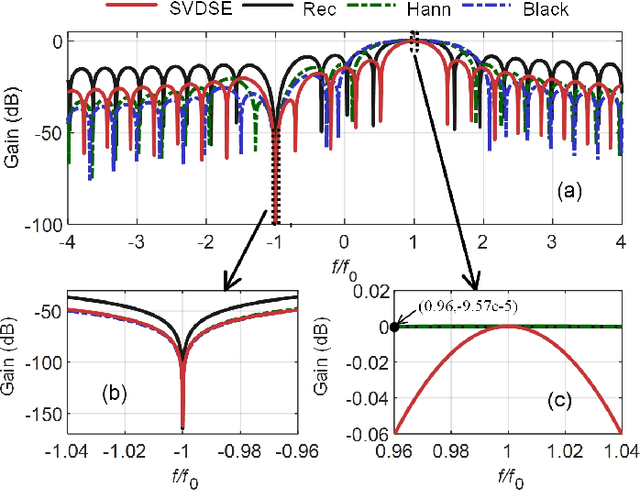
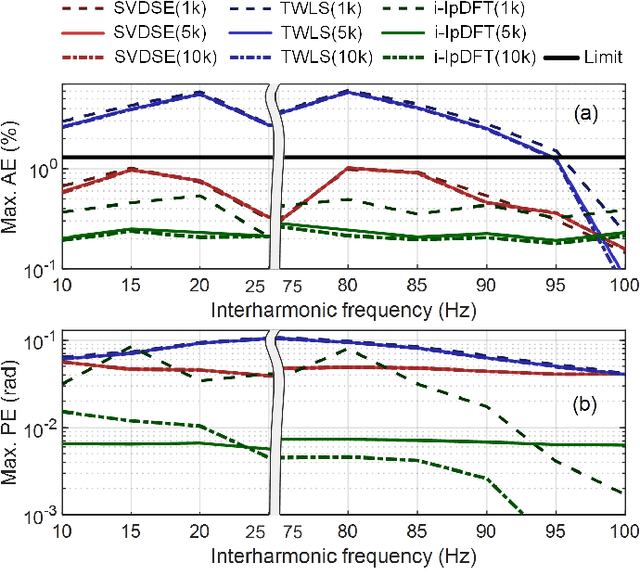
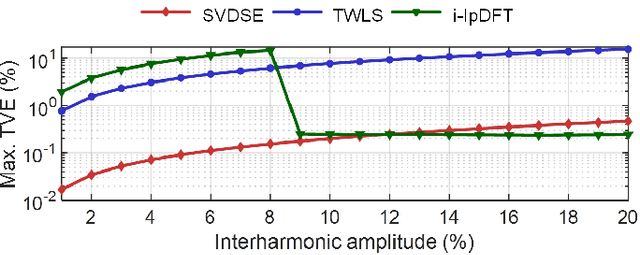

Abstract:The increasing use of renewable generation, power electronic devices, and nonlinear loads in power systems brings more severe interharmonic tones to the measurand, which can increase estimation errors of P-class PMUs, cause misoperation of protection relays, and even threaten the stability of the power systems. Therefore, the performance of the P-class synchrophasor estimator under interharmonic interference should be evaluated and new estimation schemes that can improve the operational robustness are needed for various protection and control applications. In this paper, a synchrophasor estimator design for P-class PMUs that introduces singular value decomposition to the least square algorithm based on the Taylor series is proposed. By constructing an optimization with proposed adjustable parameters, finite impulse response filters with high transition band attenuation are designed. Numerical and experimental tests verify the proposed dynamic synchrophasor estimator performance and show an effective improvement in rejecting interharmonic tones, especially when a short time window and light computational burden are required.
A Two-Stage Wavelet Decomposition Method for Instantaneous Power Quality Indices Estimation Considering Interharmonics and Transient Disturbances
Jan 10, 2021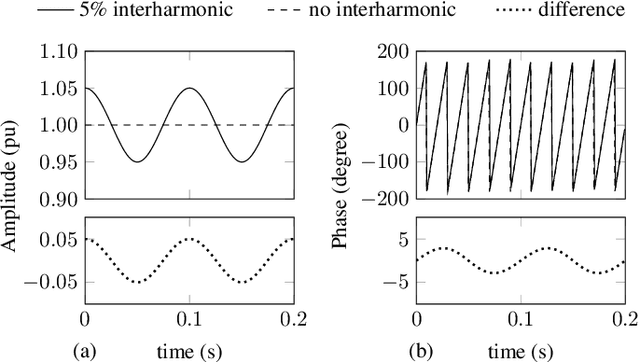
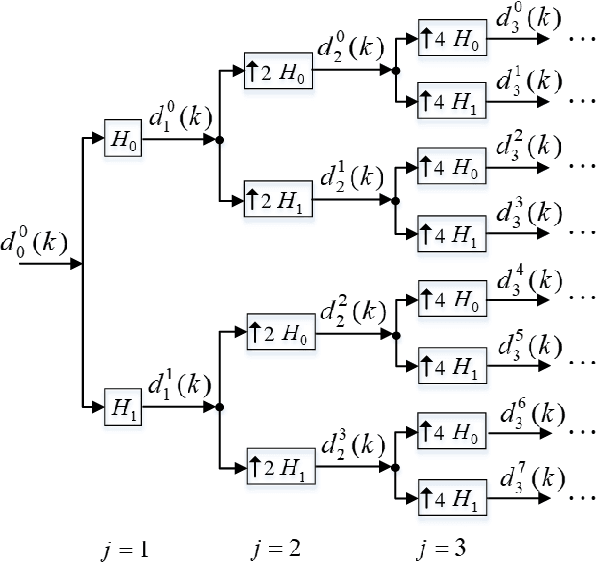
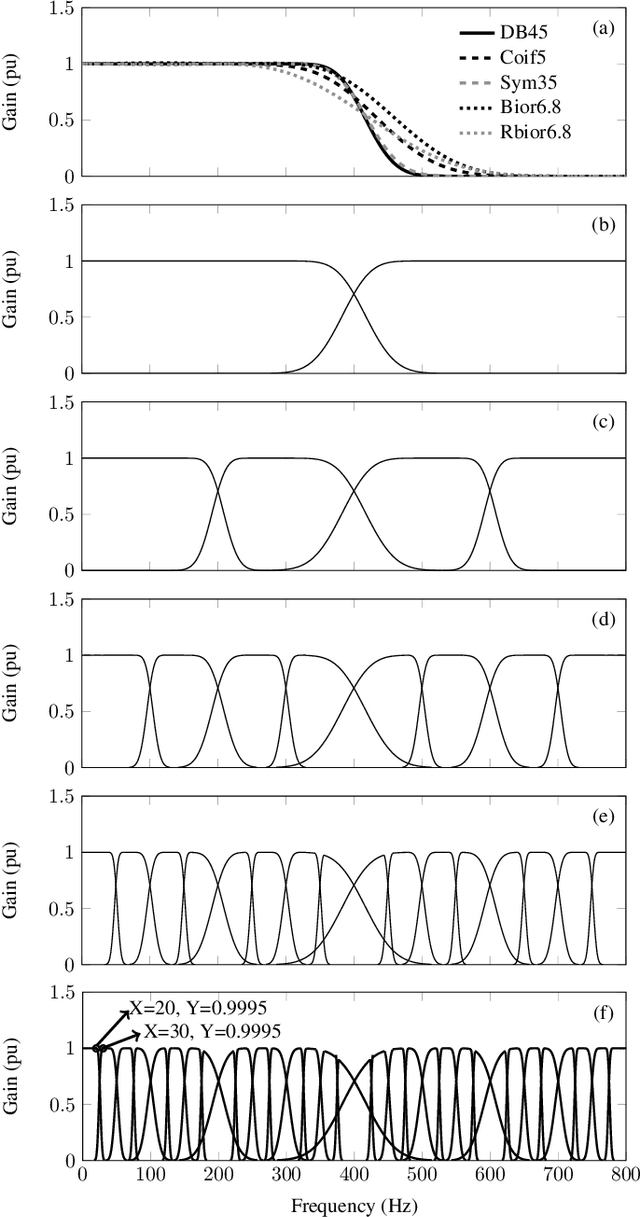
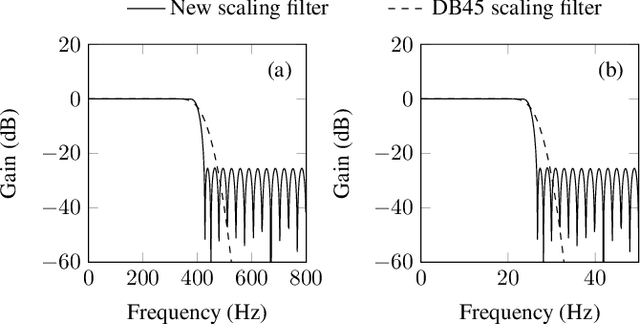
Abstract:As the complexity increases in modern power systems, power quality analysis considering interharmonics has become a challenging and important task. This paper proposes a novel decomposition and estimation method for instantaneous power quality indices (PQIs) monitoring in single-phase and three-phase systems with interharmonics and transient disturbances. To separate the interharmonic components, a set of new scaling filter and wavelet filter with narrow transition bands are designed for the undecimated wavelet packet transform (UWPT). Further, a two-stage decomposition method for multi-tone voltage and current signals is proposed. The Hilbert transform (HT) is applied to calculate the instantaneous amplitude and phase of each frequency component, which accordingly allows the monitoring of different PQI parameters. Numerical tests are conducted to check the performance of the proposed method. The test results show that compared to other conventional approaches, instantaneous PQIs estimated by the proposed method present significant advances for tracking transitory changes in power systems, and could be considered as a helpful tool for high-accuracy PQ detections.
 Add to Chrome
Add to Chrome Add to Firefox
Add to Firefox Add to Edge
Add to Edge